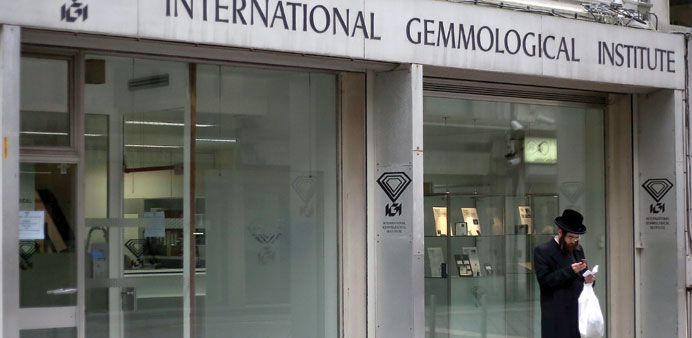A man stands outside the International Gemmological Institute in Antwerp. The city is the world’s main diamond-trading centre.
By Sebastian Kunigkeit
The room where diamonds get their glitter resembles a junk shop, strewn with tools and old-fashioned gadgets: a dusty push-button telephone; a tiny tube television; a toaster.
Amid the clutter, master diamond cutter Pieter Bombeke, an amiable, balding man in his early 60s wearing large, amber-coloured eyeglasses, sits at a whirring polishing wheel with some precious stones.
A broad smile was nearly lost in his grey goatee and moustache.
“This stone was cut in the 18th century,” he estimated, pointing to a small diamond he gripped in a pair of pliers. “It has lustre but no fire.”
Again and again, Bombeke deftly laid the tool on the rotating wheel. Each time, the diamond lost a little mass and gained in form. “Every stone is different,” he said.
In the nondescript hallway outside his workshop hung three video cameras. Behind almost every door in Antwerp’s venerable diamond district, valuable gems are being cut, polished, inspected or traded, a business worth billions of dollars annually.
Bombeke learned his craft there in the 1960s, when the Belgian port was still a key diamond cutting and polishing centre.
The 57- or 58-faceted “brilliant cut,” now typical of most diamonds, was created in Antwerp in 1919.
The city has long since lost its lead in the labour-intensive business of cutting and polishing stones, however.
“We’ve seen a decrease in the number of diamonds that are cut or polished here,” said Caroline De Wolf, spokesperson for the Antwerp World Diamond Centre (AWDC). Wages for cutters and polishers in countries such as India and China are substantially lower — “a competition we can’t win.”
Diamond trading, in which Antwerp remains pre-eminent, has also seen a shift. Jewish dealers in skullcaps and sidelocks, once the norm, are now in the minority due to the growing influx of Indians and other Asians.
The diamond district, which covers several city blocks bisected by Hoveniersstraat, or gardener’s street, abuts the train station and has its own police station. There are many surveillance cameras and also emergency telephones at 100m intervals.
Entry is restricted by bollard gates.
The gems themselves are hidden behind ageing facades of grey concrete.
“We’re still No. 1 in wholesale,” De Wolf declared. “As much as 80% of all rough diamonds and 50% of all polished diamonds are traded in Antwerp — a rather large number for a single street.”
Some 1,800 companies are active in the district. According to the AWDC, Antwerp dealers exported $26.7bn worth of diamonds in 2012. Prices have risen since the global financial crisis bottomed out in 2009.
Demand on the world market is high, mostly due to relatively low diamond output and the economic upswing in large developing countries. In India and China, in particular, diamond sales are up.
“A growing number of consumers (in those two countries) are adopting the Western practice of giving gifts of diamond jewellery to celebrate engagements, weddings and anniversaries,” reported the Boston-based business consulting firm Bain & Company recently.
De Wolf noted, “A lot of people there can afford diamonds for the first time in their life.”
This has changed the business. For example, while Americans like large diamonds, even if they are of lower quality, Asians want perfection — for Antwerp, both an opportunity and a danger.
The diamond dealers’ world is a special one. Deals are still concluded with a handshake and the words “mazal u’bracha,” Hebrew for “good luck and blessings.” Trust is crucial.
On a wall at Antwerpsche Diamantkring, one of Antwerp’s four diamond bourses, are the names of dealers blacklisted for violating the industry’s code of ethics. Only bourse members may view the wall.
Looking out at lively Hoveniersstraat from the open-plan offices of the AWDC, the diamond district’s smallness is evident. “It makes deal-making easier,” De Wolf said. “And it makes it easier for us to provide a high level of security.”
Not surprisingly, traders were shocked at February’s spectacular heist of diamonds being transported from Antwerp. A heavily armed gang cut through the perimeter fence at Brussels airport, broke into the cargo hold off a Swiss airplane waiting for take-off to Zurich and took rough diamonds valued at $50mn.
“It’s hard for us to understand how such a robbery took place,” the AWDC said at the time. Several suspects were later arrested.
Visitors who take a short ride up in a lift and pass through a security door system can see gemologists bent over magnifying glasses and microscopes under small lamps in an AWDC laboratory.
Silent and focused, they grade diamonds according to the “four C’s”: carat, clarity, colour and cut. What they type into their computers determines the price of the gems.
A 0.95-carat diamond (a carat equals 0.2g) that has a “triple excellent” cut — perfect symmetry — and has been perfectly polished sells on the Internet for about $19,000. A diamond that is slightly different in only a single category costs about $2,000 less.
Every diamond is graded three times in the laboratory before a diamond certificate is issued, and even more times if the results are not identical.
Tradition, expertise and quality are what Antwerp sees as its trump cards vis-a-vis the international competition. Whether it succeeds remains to be seen. Bombeke, for his part, expresses confidence.
“All the logistics are here,” he said. “Co-operation is good among customs, tax authorities, insurance companies and transport.”
He works alone so as not to reveal his craftsmanship secrets. Bombeke proudly talked about his special cuts: diamonds with an unusually high number of facets or unusual light reflection, such as a Star of David or a Mercedes star.
While simple cuts can be done anywhere in the world, he said, “people always still come to Antwerp for the difficult models.” — DPA
Staff in the Antwerp World Diamond Centre laboratory check gems and assess their value.

